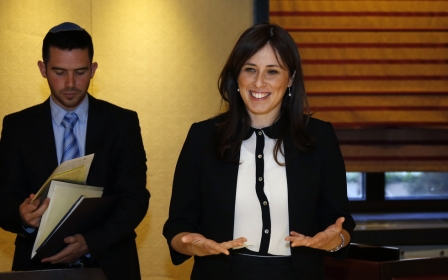Netanyahu's 'damage control' does a whole lot of damage

An editor for Israel’s most popular news site, Ynet, was recently sacked at the personal insistence of Prime Minister Benjamin Netanyahu. This is the end result of a bizarre story that briefly gripped the media pages in Israel. The very fact of Netanyahu’s personal and very public involvement is strange enough. In recent years, he had dedicated such unflattering attention to only one other journalist, who had earned it by publishing a string of damaging exposes about the prime minister. The journalist sacked this week, by contrast, published a badly photo shopped image of Netanyahu on his Facebook page, removing it almost at once. But the story of his dismissal is driven by a ping-pong match of dog-whistle associations and draws on much deeper currents in Israeli politics.
The affair began approximately three weeks ago, when Ynet published an unflattering but real picture of the prime minister. In the picture, taken when Netanyahu paid a visit to the border between Israel and the Gaza Strip, the prime minister is shown looking out toward the frontier through a pair of army binoculars - with the caps still on. For an international audience, the image of a leader looking through closed binoculars is a gaffe, with a fairly unambiguous hint at the person’s clumsiness and poor suitability for office; it is a political cartoon enacted in real life.
For an Israeli audience, the sting is a deeper one: a similar picture was taken of then-Labor Leader and Defence Minister, Amir Peretz, during the Second Lebanon War. It became perhaps the most lasting image of everything that went wrong in that war, and helped make Peretz the fall guy for a military and political failure in which the entire leadership of the time had a large share. It also helped end Peretz’s leadership ambitions; even a decade after the war, it is unlikely he will ever stand for prime minister again.
The other important factor here is that Ynet is the online version of Yedioth Ahronoth, Israel’s second-largest newspaper. Yedioth is owned by Noni Mozes, a bitter enemy of Netanyahu who had done everything he could to get Netanyahu to lose the most recent elections. Since the elections, which the right-wing block won in a landslide, Yedioth bowed to the mood of the electorate and took a sharp turn to the right, even publishing the proclamation of a private crusade against the Boycott, Divestment and Sanctions movement. But the bad blood between Netanyahu and Mozes remains, and the Netanyahu binoculars picture was one of the many little jabs the magnate keeps aiming at the prime minister.
Netanyahu’s aides responded by posting on his Facebook page a picture from his younger days, showing the prime minister as a dashing young commando holding - you guessed it - a pair of binoculars. They added a suitably cocky caption on his behalf: “I’d like to reassure Yedioth and Ynet - I have a lot of experience with binoculars.”
A few days later, Netanyahu made his now-infamous allegation that the Grant Mufti of Jerusalem, Haj Amin al-Husseini, convinced Hitler to eradicate Europe’s Jews - instead of merely expelling them, as the Fuhrer supposedly intended. His outlandish claim was met with pretty much universal condemnation, and with far more ridicule - from much further afield - than the binoculars picture ever inspired.
This was when the Ynet editor (who, in full disclosure, is an old friend and erstwhile classmate of mine) posted, on his private Facebook profile, a picture of Netanyahu superimposed with a Nazi uniform, with the question of whether Netanyahu was going to say on his Facebook page something along the lines of - “I’d like to reassure Yedioth and Ynet - I have plenty of experience with final solutions.”
As punchy meta-memes go, this was a rather clumsy one - as testified to by the fact that it took no less than 400 words to explain. At the remote chance of it being taken seriously, it was also obviously highly exaggerated - for all his faults, Netanyahu is not Hitler. But it whether deliberately or not, it also hit another dog-whistle. This week, Israel marks 20 years since the assassination of prime minister Yitzhak Rabin, murdered at the peak of right-wing incitement against his leadership in the Oslo Accords. One of the symbols of this incitement were photo montage posters of Rabin in a Nazi SS uniform, brandished by protesters at a Jerusalem rally where Netanyahu, then opposition leader, was a key speaker. Gallons of ink have been spilled on the question whether Netanyahu could see the posters from his vantage point on the balcony above Zion Square. No one will ever prove for sure, but the image stuck. Despite, and perhaps because of his election victory a year later, Netanyahu was seen by many as the man who fanned the flames of incitement and then capitalised on the assassination it caused. ”Have thou murdered and also taken possession?” was a sticker on many a left-wing car when he began his first term.
Fast forward to 2015. The journalist took the picture off Facebook almost as soon as he put it on - whether because of the clunky humour or because of the risk of being misunderstood. But despite the Facebook profile being a private one, with less than 1,000 friends, someone already took a snapshot and sent it on. Within hours, Netanyahu’s page reposted the picture, naming the journalist and his employer, and asking why the media is always shocked by right-wing incitement against left-wingers, but not the other way around.
An Israeli media website later reported that unusually, Netanyahu wrote the Facebook post himself, instead of delegating to the aides who maintain his social media presence. The prime minister’s office also filed a complaint with the police, who duly called the journalist in for questioning and spent over an hour trying to figure out if they had a stronger case for incitement or for a joke (at the moment it seems they decided it was neither, and charges are not likely to be pressed). A day later, the journalist was summoned to a hearing; a few hours later still, he was out of a job.
On one level, the story is ridiculous: the picture, which the journalist didn’t even create by himself, was not going to do any real harm, certainly not on a private Facebook profile, certainly not when the journalist himself had deleted it before it was shared by anyone else. Netanyahu’s posting, conversely, was shared over 1,500 times. So much for damage control. But it seems patently clear that Netanyahu was out to cause damage, rather than to control it - to damage a nagging rival newspaper tycoon and to damage the left by pretending that incitement from the left was as dangerous as incitement from the right (a shaky proposition; barring some scuffles at demonstration, no serious violence has ever been enacted by a left-winger on a right-winger since the end of the 1948 war).
Most directly and effectively, however, Netanyahu went baying out for the blood of a journalist who made a bad joke at his expense to a circle of friends. And when we remember that Netanyahu is a four-term prime minister, the object of adulation of the country’s biggest newspaper, and communications minister to boot, there’s precious little funny about any of this, indeed.
- Dimi Reider is an Israeli journalist, blogger and co-founder of +972 Magazine. His work has appeared in The New York Review of Books, The New York Times, The Guardian, Foreign Policy, Haaretz, Daily Beast, Al Jazeera and the Jerusalem Post. Dimi is also an Associate Policy Fellow at the European Council on Foreign Relations (ECFR).
The views expressed in this article belong to the author and do not necessarily reflect the editorial policy of Middle East Eye.
Photo: Israeli Prime Minister Benjamin Netanyahu attends a memorial service marking the 20th anniversary of the assassination of late prime minister Yitzhak Rabin in the Mt. Herzl Cemetery in Jerusalem, on October 26, 2015 (AFP)
Middle East Eye propose une couverture et une analyse indépendantes et incomparables du Moyen-Orient, de l’Afrique du Nord et d’autres régions du monde. Pour en savoir plus sur la reprise de ce contenu et les frais qui s’appliquent, veuillez remplir ce formulaire [en anglais]. Pour en savoir plus sur MEE, cliquez ici [en anglais].





